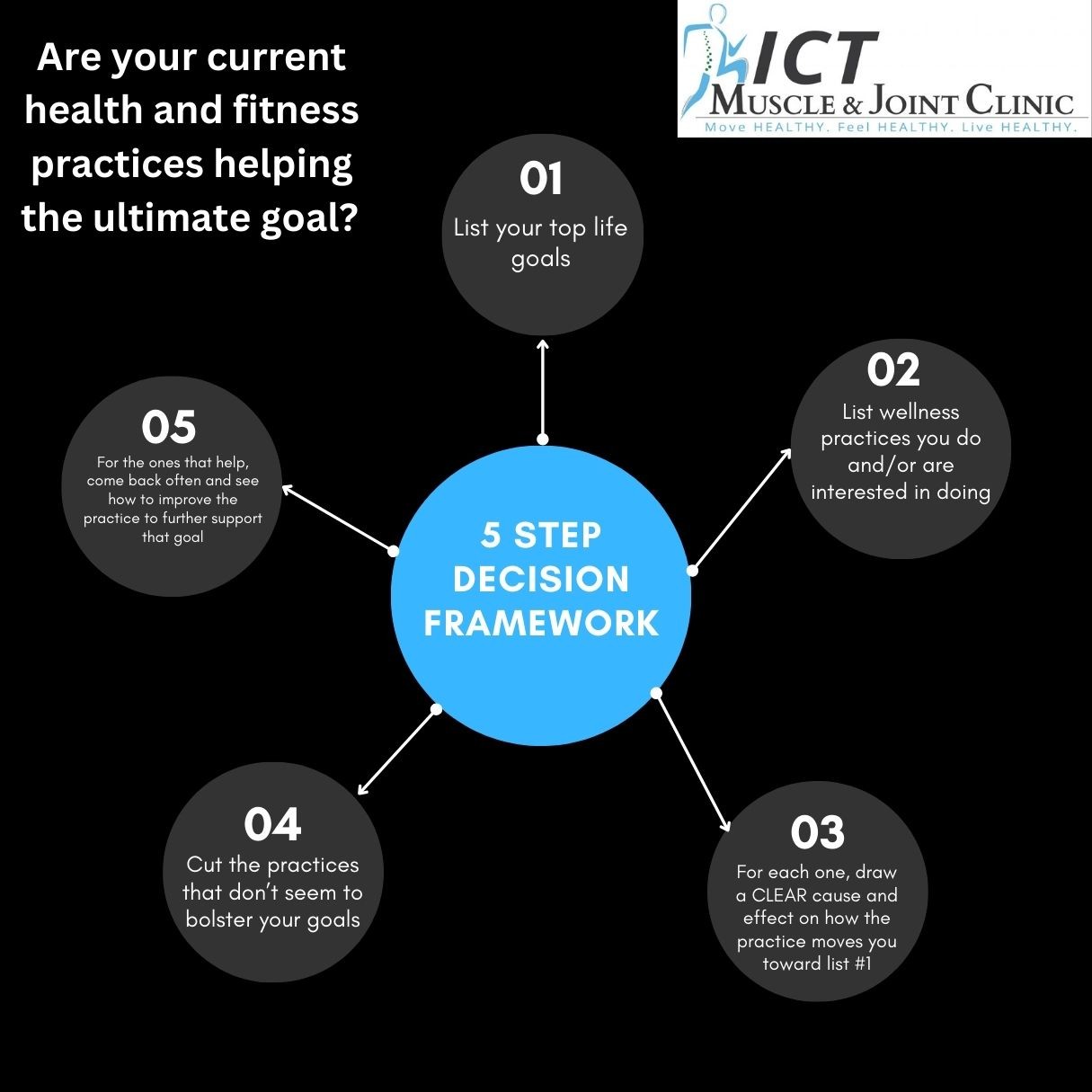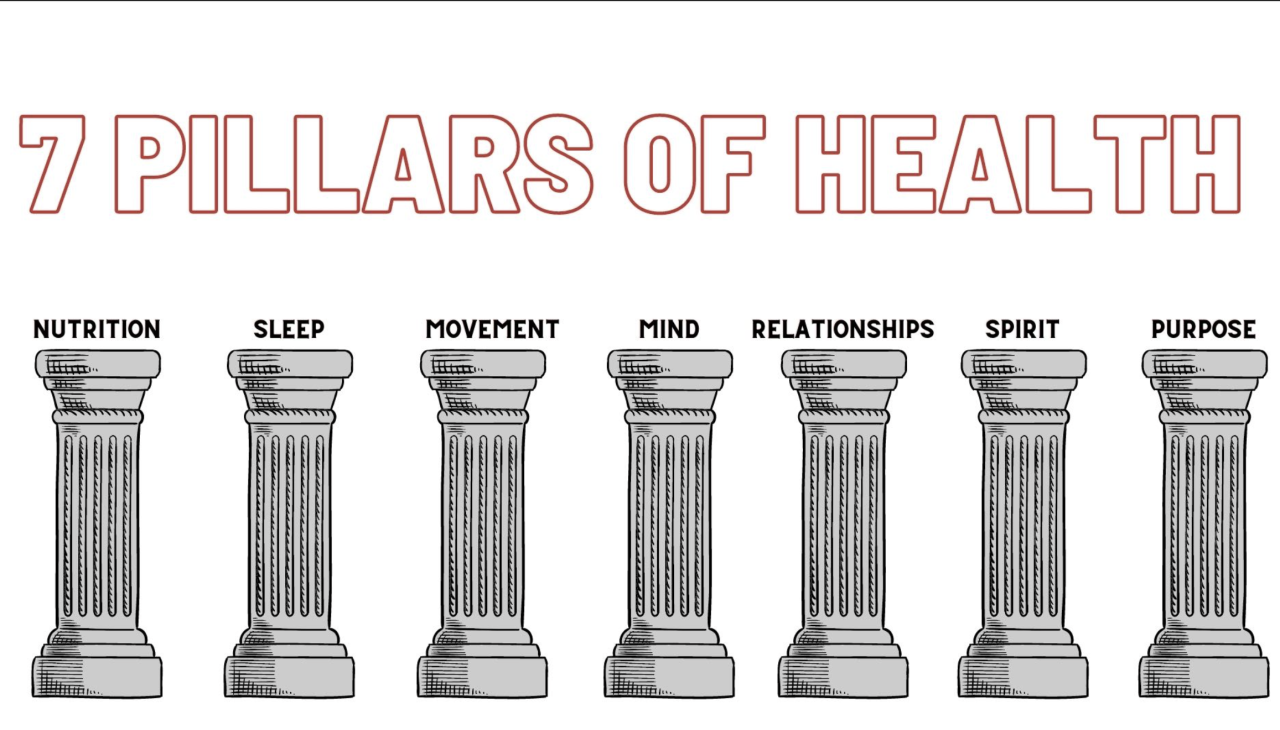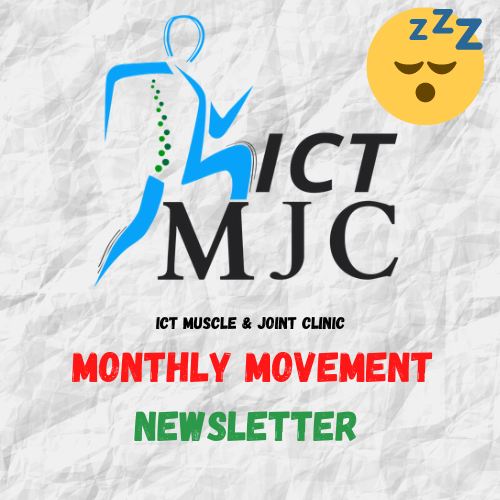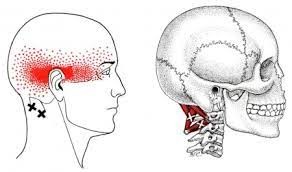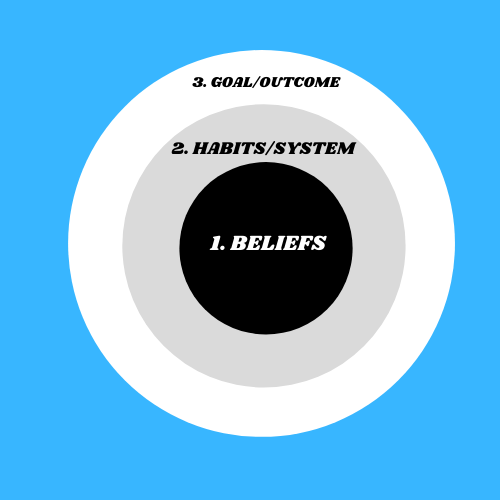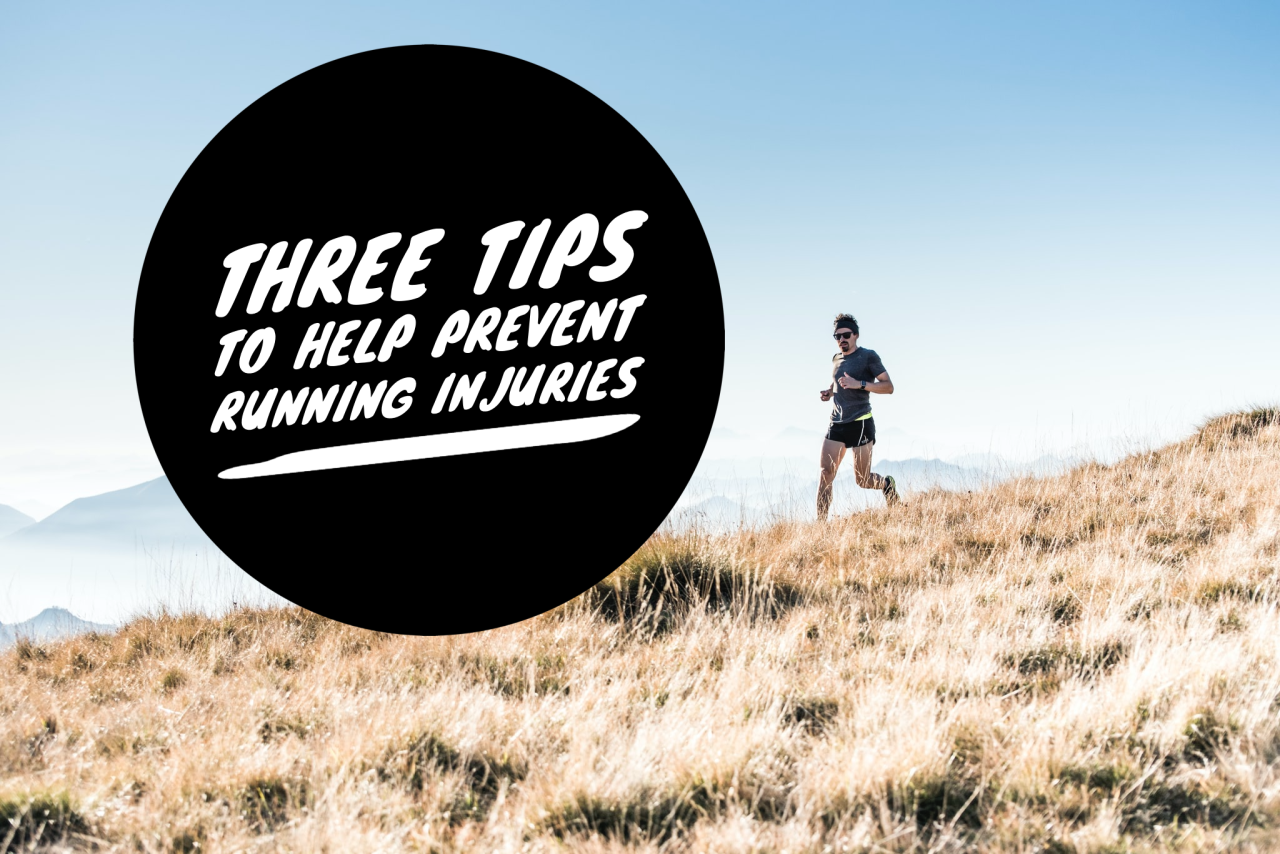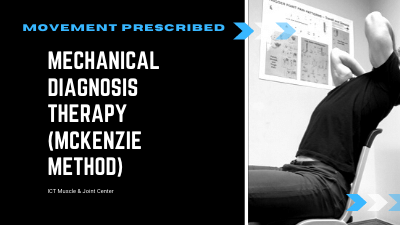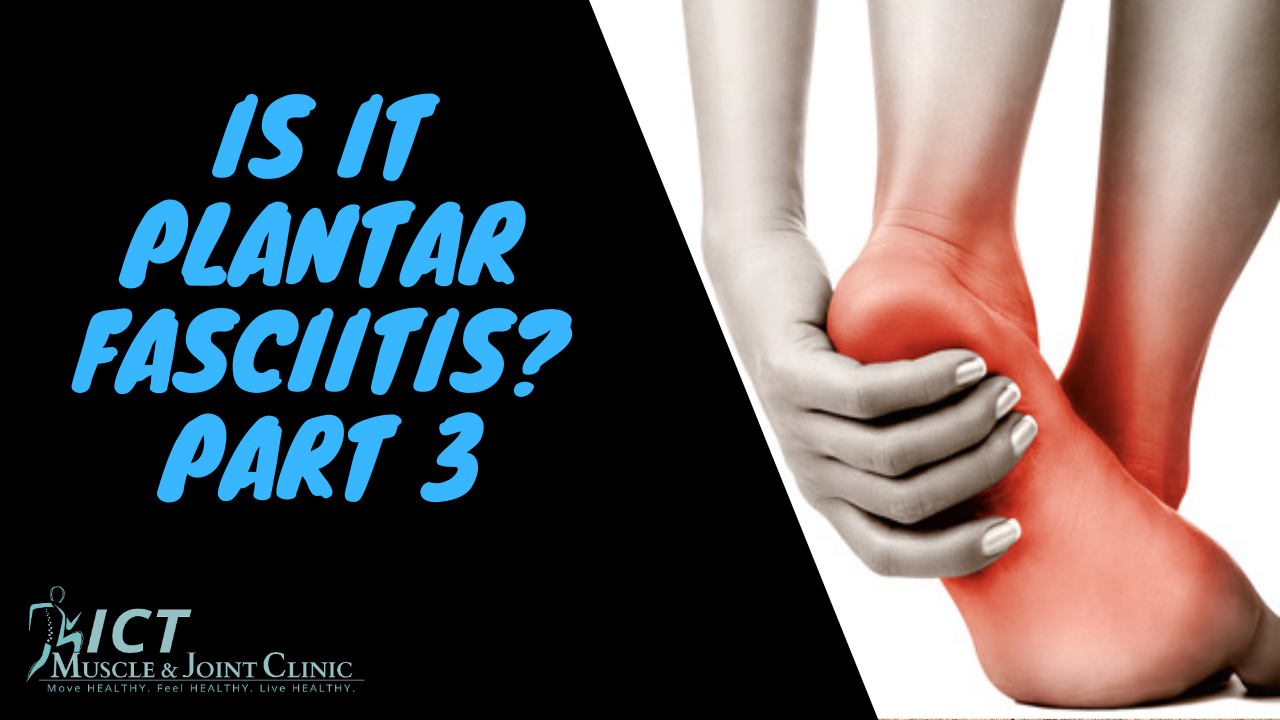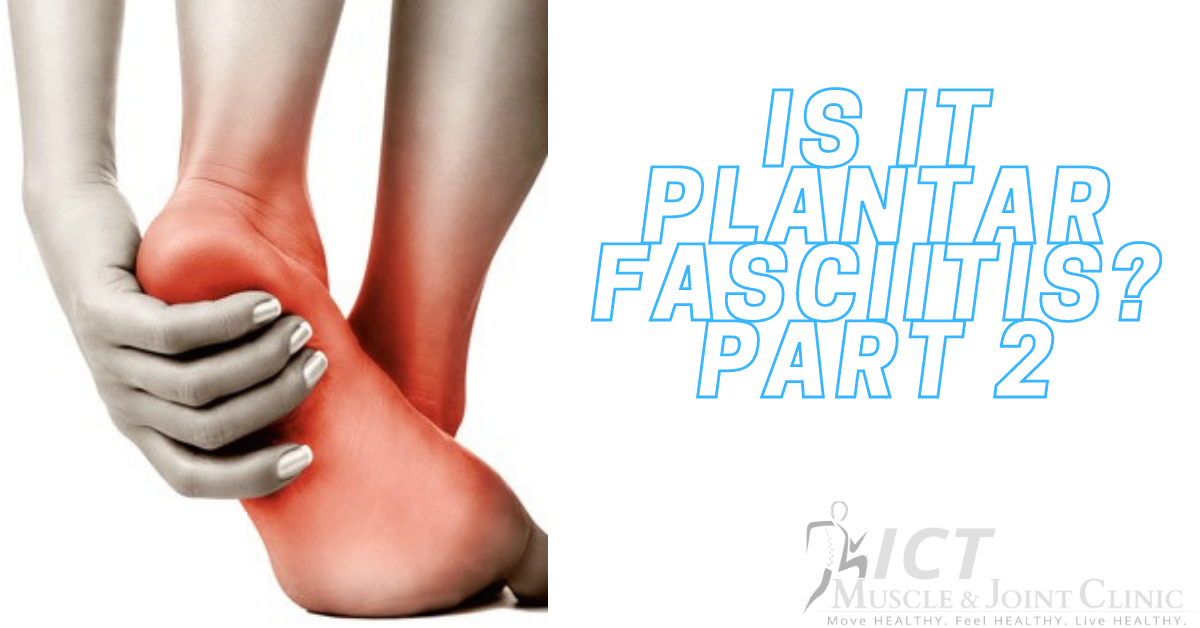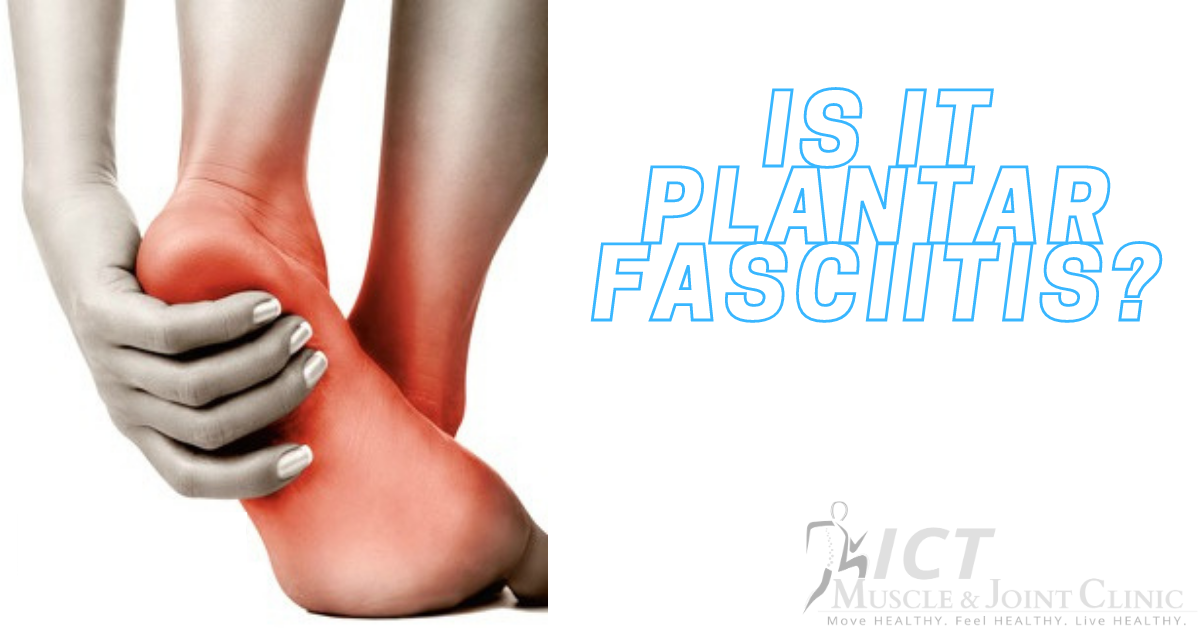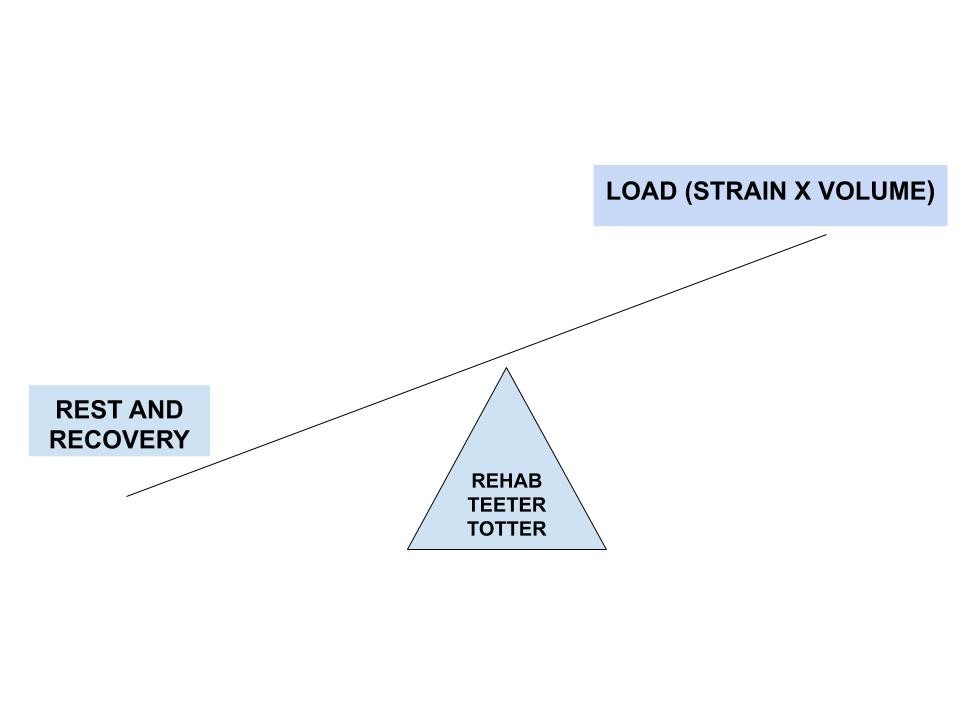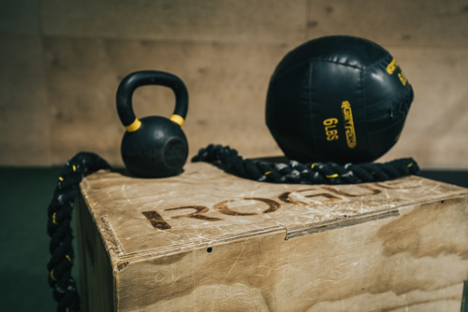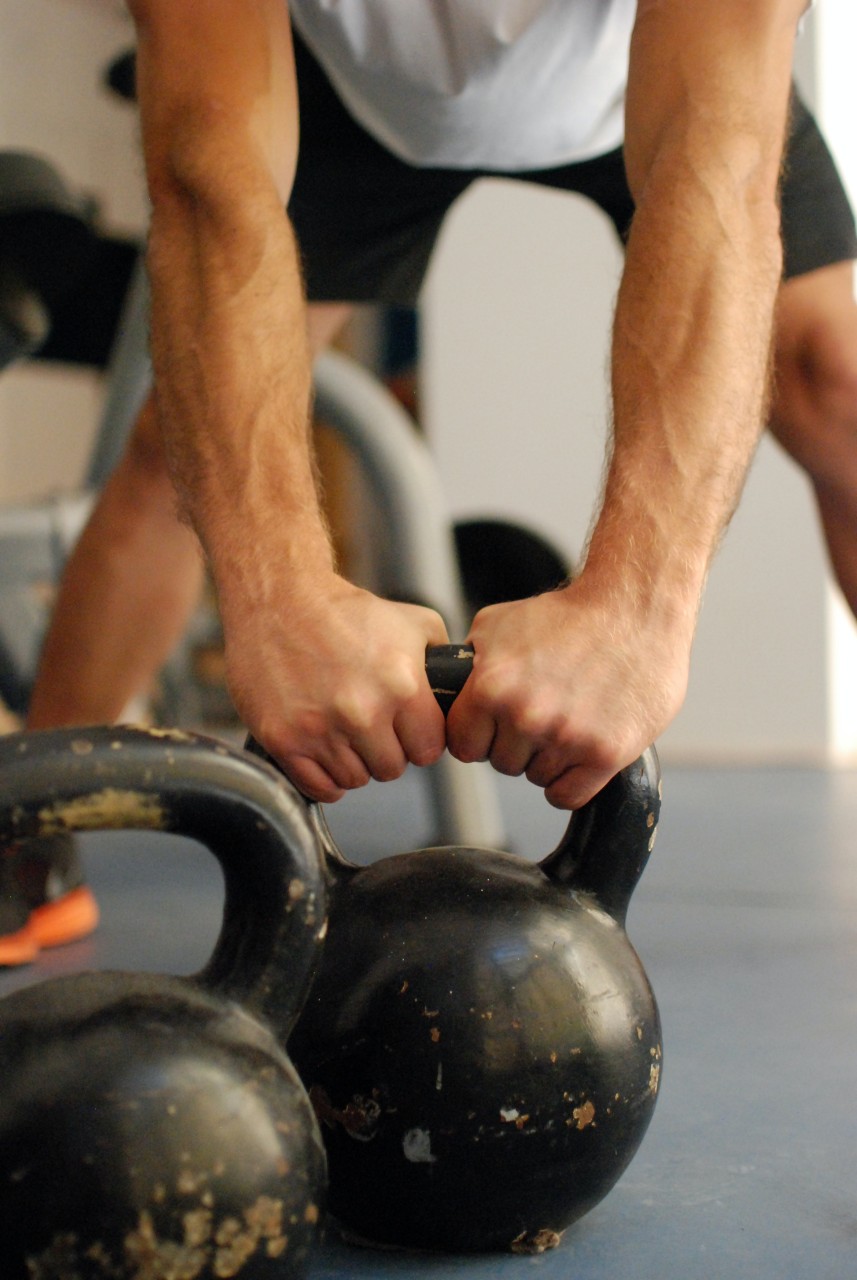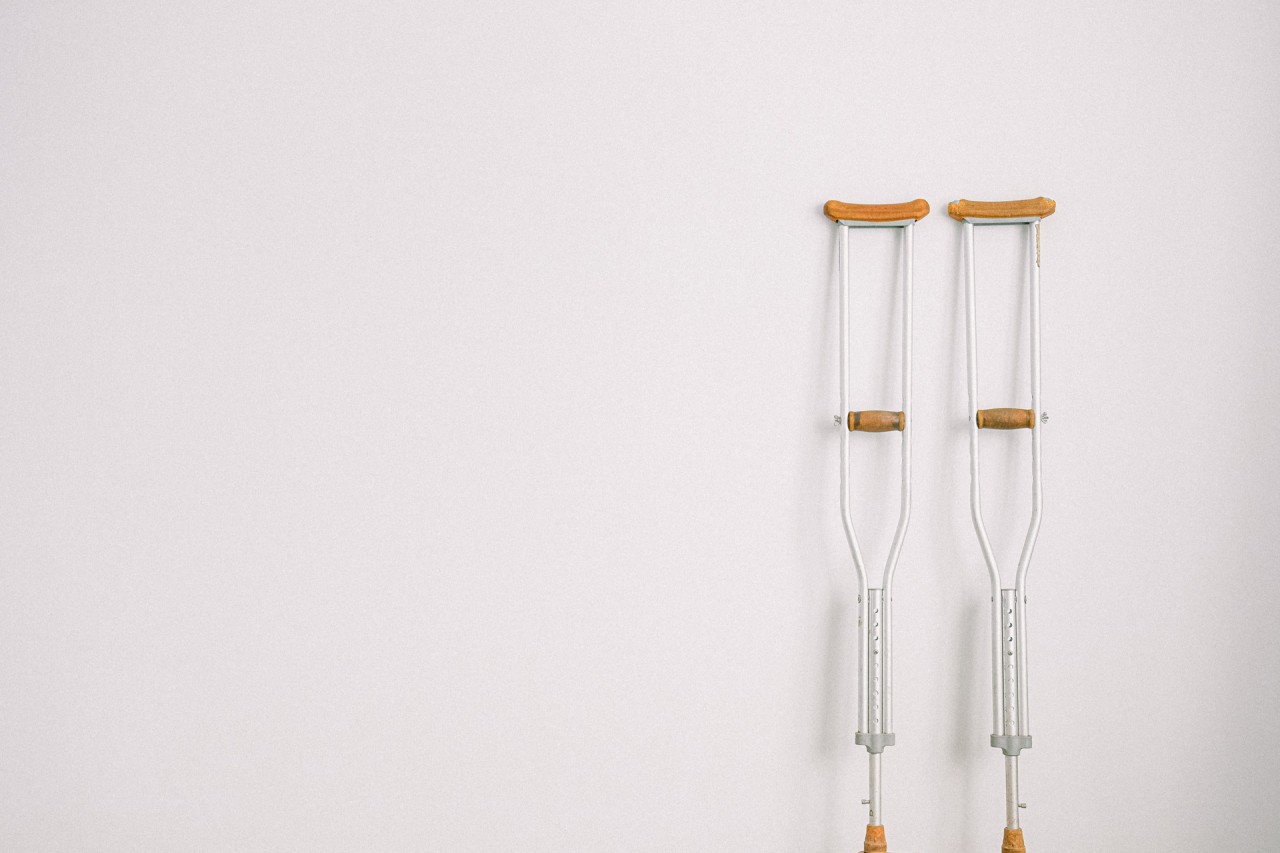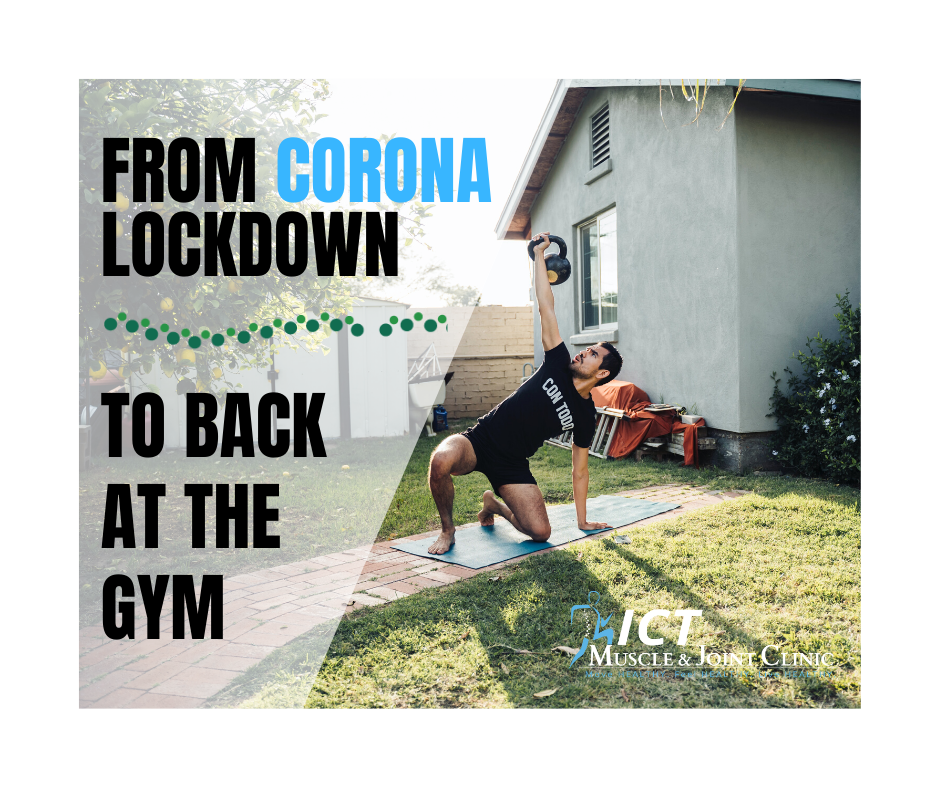Another summer has flown by and classes are starting! This may also mean your child may be needing a sports physical for their upcoming sports season. Schools require this as Kansas state law wants them to pass a physical exam prior to participation in their sport(s).
Using Health Routines to Reach Your Ultimate Goals
I will start off by saying this blog can be interpreted in three ways. Also when I say routines and practices, I mean things outside the basics. We all know exercise, sleep, nutrition, purpose, strong relationships, and stress management are vital. Doing those basics well, consistently, can already have a massive impact on your life. So with that in mind, here are the three lenses from which this blog can be interpreted though:
The Seven Pillars of Health
If you’re like the average American, you probably already failed your New Year’s Resolution. If one of your goals was to be more “healthy,” it might not even be your fault that you’ve already failed; this is because we don’t have an accurate description of “health.” How is it measured? What goes into being "healthy?"
December Movement Newsletter
We are in the end of fall season and winter starting soon which means the weather gets colder and makes for prime napping. This gets us on this month’s topic: sleep. As many of you have seen, when you fill out intake paperwork with us there are questions on sleep. We know that a main question that may pop in your head can be: “how can sleep relate to my pain and overall health?” We want to answer that as well as give you a few tips we like to use to help address sleep issues you may be having.
A Complicated Condition
One of the most debilitating complaints we will see in our office is headaches. This can either be from the intensity, duration, or both. The location can also be variable from person to person, with correlating jaw or neck pain not uncommon. We usually see a combination of these complaints as compounding factors that overlap each other, with each one needing to be addressed to help the patient best.
"Knowledge is, by far, the most powerful tool to treat and cure pain. More powerful than any pill." - Dr. David Butler, author of "Explain Pain".
About half of the running population is thought to be injured at some point in one year. These “are defined as any damage or disorder that causes significant change or even cessation of ones normal running routine.”(1) So why is this so common? Although there will never be any solution to completely prevent pain, we can try to limit the likelihood and even the severity of the running pain with the following tips. (Additionally, this may focus on our demographic of runners, but some of the same concepts can apply across all spectrums of athletics).
What Is Mechanical Diagnosis & Therapy (McKenzie Method)?
An internationally researched system of assessment and rehab for spinal and extremity musculoskeletal pain. Clinicians that have training in the Mechanical Diagnosis & Therapy (MDT) system are able to assess, classify, manage, and properly refer out when indicated for all complaints of the musculoskeletal system. This means that if a pain complaint is coming from the spine, extremity joints, muscles or tendons, then a MDT evaluation is appropriate. A clinician with MDT training will be able to identify what management strategy is best and outline a predicted recovery plan. All using movement and patient education as a guide toward self management.
The Ankle and Plantar Fasciitis
Limited Ankle Dorsiflexion (foot going toward shin) is shown to be a low to moderate risk for developing plantar fasciitis. Why? Our body is incredibly smart and even when it is lacking joint range of motion in the ankle it will still accomplish the task at hand like running, squatting, lunging by compensating and increasing strain up and down the chain. This commonly means increased demand and force placed upon the plantar fascia over time.
Treatment and rehab for plantar fasciitis can involve everything from foot, ankle, hip, and core based on your individual presentation. We will start from the bottom and move on up in an succeeding blog.
Many times, pain in the bottom of the foot or heel can be pushed into a blanket diagnosis of “you have plantar fasciitis”. But is it plantar fasciitis? Could it be another condition like tibialis posterior tendonitis, stress fracture in the heel, radiating pain from the low back? While getting a blanket diagnosis of plantar fasciitis based on zero exam with some basic rehab and soft tissue techniques thrown at it may work, there is a good chance it probably will not. You must know what you are aiming at. And in the same boat, what is causing the plantar fasciitis? Just because there is pain and inflammation in the plantar fascia does not mean that the CAUSE of the pain is coming from that area as well. In fact, it rarely does. This is why seeking out help from sports chiropractor or physical therapist is important to get a proper diagnosis and most importantly find out the main cause of the pain.
Understanding Pain
When patients present with pain, we can usually put each patient in one of two categories: they weren’t doing enough activity, or they were doing too much. Let’s give you two examples. The most obvious is in the springtime, when the weather is nicer, people will take up running; but this is after not running for months because of the season and weather. When the person tries to run the same amount of miles, or as fast as they did prior to their hiatus, is when they get in trouble. This is a simple case of "too much, too soon": the amount of excessive load on the tissues causes strain and will send a signal to the brain for help because something is wrong.
Stress loading is use of active traction and compression exercises to produce stress in the extremity with minimal motion of the painful joints. Stress loading follows the basics of exercise physiology: Your body adapts in response to demands placed on it. Your response to pain has been changed, so now any stimulus is interpreted as a painful stimulus. Stressful exercise is needed to override what has become "abnormally normal" for that area. An overload is required to achieve a training effect and to break the pain cycle that you and your body are experiencing. This means you need to do something to overload your neural, vascular, sensorimotor, and musculoskeletal systems to break the existing pain patterns your body is feeling.
WHAT IS OVERUSE PAIN?
Overuse pain is one of the most common forms of musculoskeletal pain. Muscles and joints of the body do not receive proper blood flow or oxygen. The lack of oxygen allows acid and chemicals to build up in the muscles and joints, causing local tissue irritation and pain.
I am always asked “When should I come see you” or “When should I see a chiropractor”. These questions are not always clearly outlined by the chiropractic profession. If you ask 5 different chiropractors and you’ll probably get 5 different answers. For this blog, let us tackle “When should I see a chiropractor” based on my symptoms.
PAIN GUIDELINES
First off it has to be said, if you have a NEW INJURY that is causing pain and is not getting better with any techniques you are doing at home please see a rehab specialist as soon as possible to get it assessed. 𝘎𝘳𝘪𝘯𝘥𝘪𝘯𝘨 𝘵𝘩𝘳𝘰𝘶𝘨𝘩 𝘱𝘢𝘪𝘯 𝘪𝘯 𝘸𝘰𝘳𝘬𝘰𝘶𝘵𝘴 𝘢𝘯𝘥 𝘥𝘢𝘪𝘭𝘺 𝘢𝘤𝘵𝘪𝘷𝘪𝘵𝘪𝘦𝘴 𝘪𝘴 𝘯𝘰𝘵 𝘯𝘰𝘳𝘮𝘢𝘭. 𝘈𝘭𝘴𝘰 𝘪𝘧 𝘺𝘰𝘶 𝘴𝘵𝘢𝘳𝘵 𝘵𝘰 𝘯𝘰𝘵𝘪𝘤𝘦 𝘢 𝘥𝘦𝘤𝘳𝘦𝘢𝘴𝘦 𝘪𝘯 𝘳𝘢𝘯𝘨𝘦 𝘰𝘧 𝘮𝘰𝘵𝘪𝘰𝘯 𝘪𝘯 𝘢 𝘫𝘰𝘪𝘯𝘵 𝘥𝘶𝘳𝘪𝘯𝘨 𝘢 𝘸𝘰𝘳𝘬𝘰𝘶𝘵 𝘰𝘳 𝘥𝘢𝘪𝘭𝘺 𝘢𝘤𝘵𝘪𝘷𝘪𝘵𝘺 𝘵𝘩𝘢𝘵 𝘪𝘴 𝘯𝘰𝘵 𝘨𝘦𝘵𝘵𝘪𝘯𝘨 𝘣𝘦𝘵𝘵𝘦𝘳, 𝘱𝘭𝘦𝘢𝘴𝘦 𝘵𝘢𝘬𝘦 𝘯𝘰𝘵𝘦. 𝘗𝘢𝘪𝘯 𝘪𝘴 𝘶𝘴𝘶𝘢𝘭𝘭𝘺 𝘵𝘩𝘦 𝘭𝘢𝘴𝘵 𝘵𝘩𝘪𝘯𝘨 𝘵𝘰 𝘤𝘰𝘮𝘦 𝘰𝘯. We can save a lot of aches and pains and speed up the rehab process if these things are accessed early and not looked at until you are in unrelenting pain.
Now for this post we are talking the rehab process of an injury AFTER it has been accessed and serious red flags have been ruled out. Meaning we have a plan and are on our way to healing the injured tissue. So the questions become in this process: 𝘚𝘩𝘰𝘶𝘭𝘥 𝘐 𝘢𝘷𝘰𝘪𝘥 𝘢𝘭𝘭 𝘮𝘰𝘷𝘦𝘮𝘦𝘯𝘵𝘴 𝘵𝘩𝘢𝘵 𝘢𝘳𝘦 𝘱𝘢𝘪𝘯𝘧𝘶𝘭? 𝘞𝘩𝘦𝘯 𝘴𝘩𝘰𝘶𝘭𝘥 𝘐 𝘴𝘵𝘰𝘱 𝘥𝘰𝘪𝘯𝘨 𝘢𝘯 𝘢𝘤𝘵𝘪𝘷𝘪𝘵𝘺 𝘪𝘧 𝘪𝘵 𝘪𝘴 𝘱𝘢𝘪𝘯𝘧𝘶𝘭? 𝘓𝘦𝘵 𝘵𝘩𝘦 𝘴𝘵𝘰𝘱𝘭𝘪𝘨𝘩𝘵 𝘴𝘺𝘴𝘵𝘦𝘮 𝘣𝘦 𝘺𝘰𝘶𝘳 𝘨𝘶𝘪𝘥𝘦.
STOP LIGHT SYSTEM TO PAIN
𝐑𝐞𝐦𝐞𝐦𝐛𝐞𝐫: 𝐇𝐮𝐫𝐭 𝐝𝐨𝐞𝐬 𝐧𝐨𝐭 𝐚𝐥𝐰𝐚𝐲𝐬 𝐞𝐪𝐮𝐚𝐥 𝐡𝐚𝐫𝐦.
RED LIGHT:
1. Major loss in range of motion or strength (more than 50%) after doing an activity.
2. Pain increases during activity
3. Lingering pain (not workout soreness) that last several days after doing an activity.
𝐀𝐜𝐭𝐢𝐨𝐧 𝐏𝐥𝐚𝐧: STOP THE ACTIVITY THAT CAUSED IT 𝐚𝐧𝐝 𝐬𝐞𝐞𝐤 𝐦𝐞𝐝𝐢𝐜𝐚𝐥 𝐚𝐝𝐯𝐢𝐜𝐞 𝐟𝐫𝐨𝐦 𝐲𝐨𝐮𝐫 𝐫𝐞𝐡𝐚𝐛 𝐩𝐫𝐨𝐟𝐞𝐬𝐬𝐢𝐨𝐧𝐚𝐥.
YELLOW LIGHT:
1. No change in range of motion, strength, and function.
2. Pain spikes during the activity.
3. Pain persists AFTER activity by 3 numbers (ex: 2/10 to 5/10) for more than couple hours or you wake up the next day and is still spiking.
𝐀𝐜𝐭𝐢𝐨𝐧 𝐏𝐥𝐚𝐧: 𝐑𝐞𝐦𝐞𝐦𝐛𝐞𝐫 𝐚 𝐟𝐥𝐚𝐫𝐞 𝐮𝐩 𝐢𝐧 𝐩𝐚𝐢𝐧 𝐝𝐨𝐞𝐬 𝐍𝐎𝐓 𝐞𝐪𝐮𝐚𝐥 𝐡𝐚𝐫𝐦. 𝐈𝐭 𝐢𝐬 𝐚 𝐩𝐚𝐫𝐭 𝐨𝐟 𝐭𝐡𝐞 𝐩𝐫𝐨𝐜𝐞𝐬𝐬 𝐚𝐧𝐝 𝐢𝐭 𝐣𝐮𝐬𝐭 𝐦𝐞𝐚𝐧𝐬 𝐭𝐨𝐨 𝐦𝐮𝐜𝐡 𝐭𝐨𝐨 𝐟𝐚𝐬𝐭. 𝐓𝐚𝐤𝐞 𝐧𝐨𝐭𝐞 𝐚𝐧𝐝 𝐬𝐭𝐚𝐲 𝐜𝐨𝐮𝐫𝐬𝐞 𝐰𝐢𝐭𝐡 𝐧𝐨𝐫𝐦𝐚𝐥 𝐚𝐜𝐭𝐢𝐯𝐢𝐭𝐲. 𝐀𝐯𝐨𝐢𝐝 𝐢𝐧𝐜𝐫𝐞𝐚𝐬𝐢𝐧𝐠 𝐚𝐜𝐭𝐢𝐯𝐢𝐭𝐲 (𝐬𝐩𝐞𝐞𝐝, 𝐥𝐨𝐚𝐝, 𝐯𝐨𝐥𝐮𝐦𝐞 𝐨𝐟 𝐚𝐧 𝐞𝐱𝐞𝐫𝐜𝐢𝐬𝐞) 𝐨𝐫 𝐚𝐝𝐝𝐢𝐧𝐠 𝐚𝐧𝐲 𝐧𝐞𝐰 𝐚𝐜𝐭𝐢𝐯𝐢𝐭𝐲. 𝐈𝐟 𝐬𝐚𝐦𝐞 𝐩𝐚𝐭𝐭𝐞𝐫𝐧 𝐜𝐨𝐧𝐭𝐢𝐧𝐮𝐞𝐬 𝐭𝐡𝐞 𝐧𝐞𝐱𝐭 𝐭𝐢𝐦𝐞, 𝐝𝐞𝐜𝐫𝐞𝐚𝐬𝐞 𝐚𝐜𝐭𝐢𝐯𝐢𝐭𝐲 𝐛𝐲 𝟓𝟎% (𝐥𝐨𝐚𝐝, 𝐬𝐞𝐭𝐬, 𝐫𝐞𝐩𝐬, 𝐝𝐮𝐫𝐚𝐭𝐢𝐨𝐧, 𝐬𝐩𝐞𝐞𝐝) 𝐚𝐧𝐝 𝐠𝐨 𝐛𝐚𝐜𝐤 𝐚𝐧𝐝 𝐬𝐞𝐞 𝐢𝐟 𝐩𝐞𝐫𝐬𝐢𝐬𝐭𝐢𝐧𝐠 𝐩𝐚𝐢𝐧 𝐝𝐞𝐜𝐫𝐞𝐚𝐬𝐞𝐬. 𝐈𝐟 𝐢𝐭 𝐢𝐬 𝐛𝐞𝐭𝐭𝐞𝐫 𝐭𝐡𝐞𝐧 𝐬𝐭𝐚𝐲 𝐭𝐡𝐞𝐫𝐞 𝐟𝐨𝐫 𝐜𝐨𝐮𝐩𝐥𝐞 𝐝𝐚𝐲𝐬 𝐚𝐧𝐝 𝐭𝐡𝐞𝐧 𝐢𝐧𝐜𝐫𝐞𝐚𝐬𝐞 𝐚𝐜𝐭𝐢𝐯𝐢𝐭𝐲 𝐠𝐫𝐚𝐝𝐮𝐚𝐥𝐥𝐲 𝐚𝐠𝐚𝐢𝐧. 𝐈𝐟 𝐢𝐭 𝐢𝐬 𝐧𝐨𝐭 𝐭𝐡𝐞𝐧 𝐜𝐨𝐧𝐬𝐮𝐥𝐭 𝐲𝐨𝐮𝐫 𝐫𝐞𝐡𝐚𝐛 𝐩𝐫𝐨𝐟𝐞𝐬𝐬𝐢𝐨𝐧𝐚𝐥.
GREEN LIGHT:
1. No change in range of motion, strength, and function.
2. Pain spikes during the activity.
3. Pain is no worse after activity and back to baseline after few minutes.
𝐀𝐜𝐭𝐢𝐨𝐧 𝐏𝐥𝐚𝐧: 𝐒𝐭𝐚𝐲 𝐭𝐡𝐞 𝐜𝐨𝐮𝐫𝐬𝐞. 𝐁𝐞 𝐜𝐨𝐧𝐟𝐢𝐝𝐞𝐧𝐭 𝐚𝐧𝐝 𝐠𝐫𝐚𝐝𝐮𝐚𝐥𝐥𝐲 𝐥𝐨𝐚𝐝 𝐚𝐧𝐝 𝐜𝐡𝐚𝐥𝐥𝐞𝐧𝐠𝐞 𝐭𝐡𝐞 𝐭𝐢𝐬𝐬𝐮𝐞 𝐦𝐨𝐫𝐞 𝐚𝐧𝐝 𝐦𝐨𝐫𝐞 𝐨𝐯𝐞𝐫 𝐭𝐢𝐦𝐞.
HOW ICT MUSCLE & JOINT CAN HELP YOUR PAIN
𝘏𝘦𝘳𝘦 𝘢𝘵 𝘐𝘊𝘛 𝘔𝘶𝘴𝘤𝘭𝘦 & 𝘑𝘰𝘪𝘯𝘵 in Wichita 𝘸𝘦 𝘩𝘢𝘷𝘦 𝘵𝘦𝘤𝘩𝘯𝘪𝘲𝘶𝘦𝘴 𝘭𝘪𝘬𝘦 𝘤𝘩𝘪𝘳𝘰𝘱𝘳𝘢𝘤𝘵𝘪𝘤 𝘢𝘥𝘫𝘶𝘴𝘵𝘪𝘯𝘨, 𝘥𝘳𝘺 𝘯𝘦𝘦𝘥𝘭𝘪𝘯𝘨, 𝘐𝘈𝘚𝘛𝘔, 𝘢𝘯𝘥 𝘤𝘶𝘱𝘱𝘪𝘯𝘨 𝘵𝘰 𝘩𝘦𝘭𝘱 𝘳𝘦𝘭𝘪𝘦𝘷𝘦 𝘱𝘢𝘪𝘯 𝘢 𝘭𝘪𝘵𝘵𝘭𝘦 𝘣𝘪𝘵, 𝘣𝘶𝘵 𝘢𝘭𝘭 𝘵𝘩𝘢𝘵 𝘪𝘴 𝘢 𝘮𝘦𝘢𝘯𝘴 𝘵𝘰 𝘨𝘦𝘵 𝘺𝘰𝘶 𝘮𝘰𝘷𝘪𝘯𝘨 𝘢𝘯𝘥 𝘨𝘦𝘵 𝘺𝘰𝘶 𝘴𝘵𝘳𝘰𝘯𝘨 𝘢𝘨𝘢𝘪𝘯. We use this stop light system to help guide you to being more resilient and come out of any injury being more educated and stronger than before.
References: "A World of Hurt: A Guide to Classifying Pain"
There are a lot of misconceptions and confusion that come with rehab and recovering from an injury. Some common questions we have pop up or know people are wondering are: why am I having to do exercises at home? Can’t you just “fix” me with your treatments at your office? Why I am doing these low-grade rehab exercises at the beginning? Why am I continuing to come and progress with exercises if I am out of pain? These are just to name a few, and we will try to answer each as best we can.
There are two things behind this idea. One that everyone should be treated with the same presence, time, listening, care and attention to detail as an athlete is in today’s culture of rehab. Two that care should be dictated toward getting the patient back to moving better and finding or encouraging a movement practice they love. Just like when we are doing a “return to play” strategy with an injured athlete.
Did you know the originator of the R.I.C.E (rest, ice, compression, elevation) protocol has since redacted his stance on such for recovery of tissue/s? This was created in 1971, by Dr. Mirkin, as a standard for addressing acute injuries and has since been utilized for decades for recovery and pain management. Unfortunately, this outdated protocol is still used by athletes, in sports medicine facilities, chiropractic, physical therapy and medical clinics as a means to address injured tissue.
The Novel Coronavirus has changed the game for many across all industries. It is both frustrating (for more reasons than anyone can possible outline) and exciting. We often find adversity to be negative, but it also gives us an opportunity for re-evaluating desires and goals. When we started ICT Muscle and Joint Clinic here in Wichita, we knew we wanted to become more than a standard chiropractic clinic. We wanted to offer chiropractic adjustments, soft-tissue treatments, and physical therapy type services all under one roof, within one visit, to produce superior results. However, we have not shared more than this. We want more. With the addition of our Westside location run by Dr. Sam Reals, we set out to create a hybrid office between chiropractic care and a gym atmosphere.
